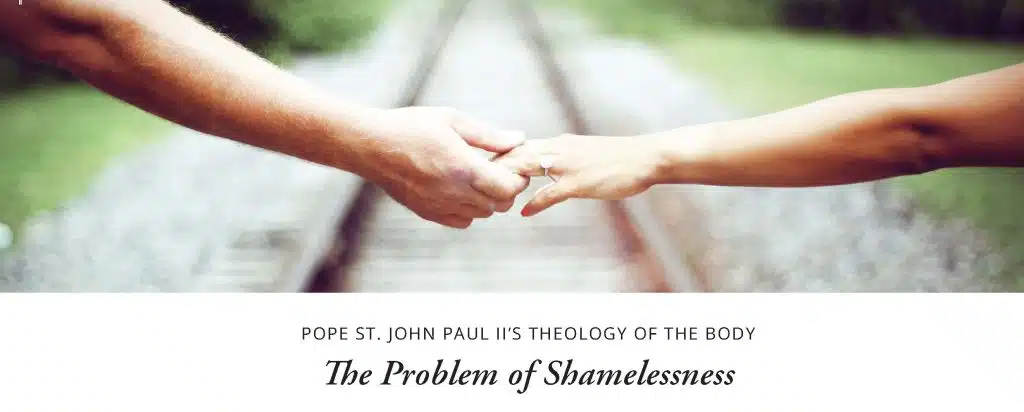The Problem of Shamelessness
 Note: This article is part of an ongoing series on Pope St. John Paul II’s “Theology of the Body” (TOB).
Note: This article is part of an ongoing series on Pope St. John Paul II’s “Theology of the Body” (TOB).
In recent articles, we have explored the emergence of shame in our first parents and all subsequent human beings after Original Sin. We saw how the emergence of concupiscence, particularly sexual desire, results in the experience of reciprocal shame by man and woman, which moves us to conceal the sexual features of our bodies from one another. Because concupiscence has been born in man’s heart, we are aware that when we look at each other’s bodies, we do not easily and immediately see the person in his or her fullness. Our eyes have, in a sense, been darkened by sin, such that our vision may only take in the body’s exterior features, which we judge and evaluate as to the potential pleasure or usefulness it may bring.
This awareness of our concupiscence gives rise to shame, which moves us to conceal the sexual features of the body so that we do not become objects of others’ disordered desires. This experience of shame has nothing to do with seeing sexuality as bad or dirty. Rather, understood in this way, shame reminds us of our dignity and the sacredness of human sexuality by protecting us from being used as mere objects. This form of shame is a healthy building block for the virtue of modesty.
Understanding the important role of shame in the lives of fallen human beings also sheds light on the problems of shamelessness evident today. One form of shamelessness involves the normalization of lust (i.e., disordered sexual desire). When lustful actions and attitudes are given approval or even celebrated, an attitude of shamelessness is being expressed and promoted: the human body is seen only as a sexual object for use without any regard for the person. Another form of shamelessness is when the human body is portrayed in such a way that its sexual appeal is accentuated above and beyond the value of the person. This can be in forms of dress and behavior and in artistic representations. The most common example of this today is pornography.
In TOB, Pope St. John Paul II contrasts pornographic representations of the human body with other artistic uses of the nude human form (see TOB 60-63). The difference between pornography and an appropriate artistic rendering of a naked human being originates in the artist’s intention. In the latter case, the intention is to depict the human person revealed through his body in a dignified way, whereas in the former, the intention is merely to present an anonymous human body as an object of lustful desire. Indeed, pornography obscures the reality of the person and over-accentuates the sexual features of the body. In this way, it turns the human body—and therefore the human person—into a mere object (i.e., an impersonal thing) to be used for selfish pleasure and even, into a commodity to be bought and sold.
The Catechism condemns pornography in no uncertain terms, saying that it “offends against chastity because it perverts the conjugal act.” It goes on to say that pornography:
“Does grave injury to the dignity of its participants (actors, vendors, the public), since each one becomes an object of base pleasure and illicit profit for others. It immerses all who are involved in the illusion of a fantasy world. It is a grave offense.” (no. 2354)
Indeed, the Church’s opposition to pornography is so absolute that the Catechism exhorts governments to make it illegal: “Civil authorities should prevent the production and distribution of pornographic materials” (no. 2354). Given all that Pope St. John Paul II taught us about the dignity of the human person and the spousal meaning of the body, this should come as no surprise. Next month, with the help of modern psychology, I will further diagnose the problems of pornography.
 Dr. Andrew Sodergren MTS, PSY.D is a Catholic psychologist and director of psychological services for Ruah Woods. He speaks on the integration of psychology and the Catholic faith. He and his wife, Ellie, have five children.
Dr. Andrew Sodergren MTS, PSY.D is a Catholic psychologist and director of psychological services for Ruah Woods. He speaks on the integration of psychology and the Catholic faith. He and his wife, Ellie, have five children.
This article appeared in the May 2023 edition of The Catholic Telegraph Magazine. For your complimentary subscription, click here.













